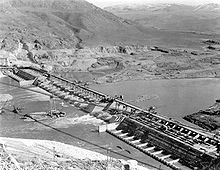Base of the dam in 1938
Roosevelt envisioned the dam would fit into his New Deal under the Public Works Administration; it would create jobs, farming opportunities and would pay for itself. In addition, as part of a larger public effort, Roosevelt wanted to keep electricity prices low by limiting private ownership of utility companies, which could charge high prices for energy.[18] Many opposed a federal takeover of the project, including its most prominent supporters, but Washington State lacked the resources to fully realize the project.[34][35] In August 1935, with the help of Roosevelt and a Supreme Court decision allowing the acquisition of public land and Indian Reservations, Congress authorized funding for the upgraded high dam under the 1935 River and Harbors Act.[36] The most significant legislative hurdle for the dam was over.[37]
That for the purpose of controlling floods, improving navigation, regulating the flow of the streams of the United States, providing for storage and for the delivery of the stored waters thereof, for the reclamation of public lands and Indian reservations, and other beneficial uses, and for the generation of electric energy as a means of financially aiding and assisting such undertakings the projects known as "Parker Dam" on the Colorado River and "Grand Coulee Dam" on the Columbia River are hereby authorized and adopted.—1935 Rivers and Harbors Act SEC 2, August 30, 1935, [H.R. 6250] [Public, No. 409][37]
First concrete pour and completion
The dam after completion and water over-topping the spillway
Until the project began, the stretch of the Columbia River where the dam was to rise was as yet unbridged, making it difficult to move men and materials.[40] In January 1936, the Grand Coulee Bridge (a permanent highway bridge) was opened after major delays caused by high water; three additional and temporary bridges downstream had moved vehicles and workers along with sand and gravel for cement mixing.[26][41] In March 1938, MWAK completed the lower dam and Consolidated Builders Inc. began constructing the high dam. The west power house was completed in December 1939 and about 5,500 workers were on site that year. Between 1940 and 1941, the dam's eleven floodgates were installed on the spillway and the dam's first generator went into operation in January 1941. The reservoir was full and the first water flowed over the dam's spillway on June 1, 1942, while work was officially complete on January 31, 1943.[42][43] The last of the original 18 generators was not operational until 1950.[2]


No comments:
Post a Comment